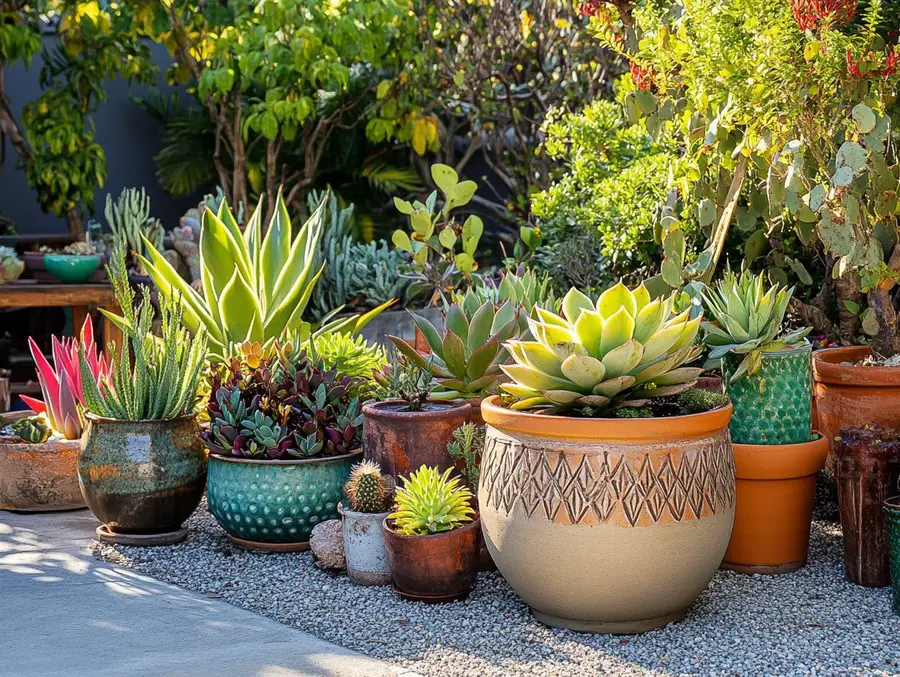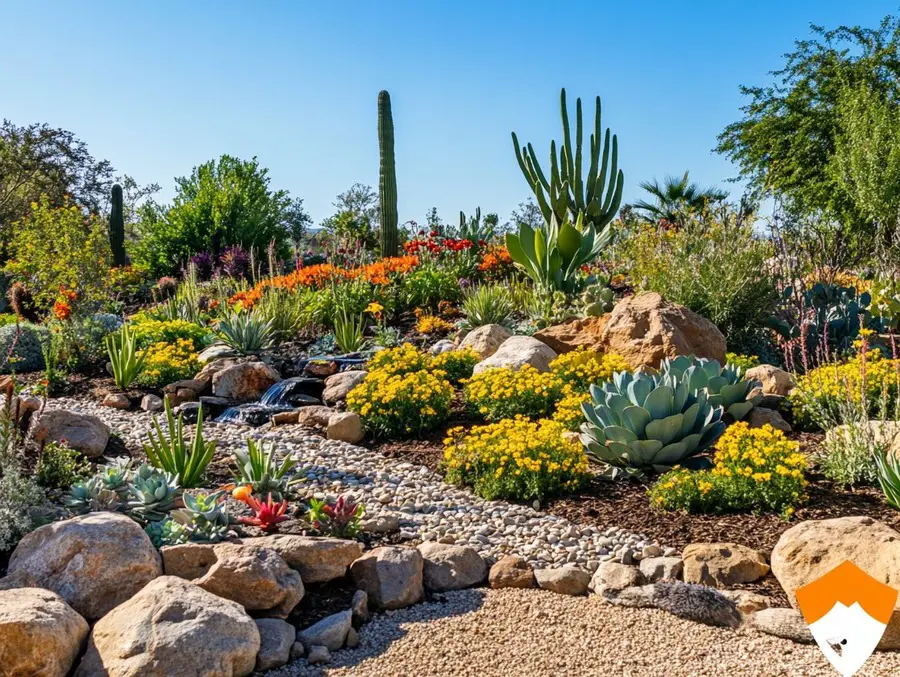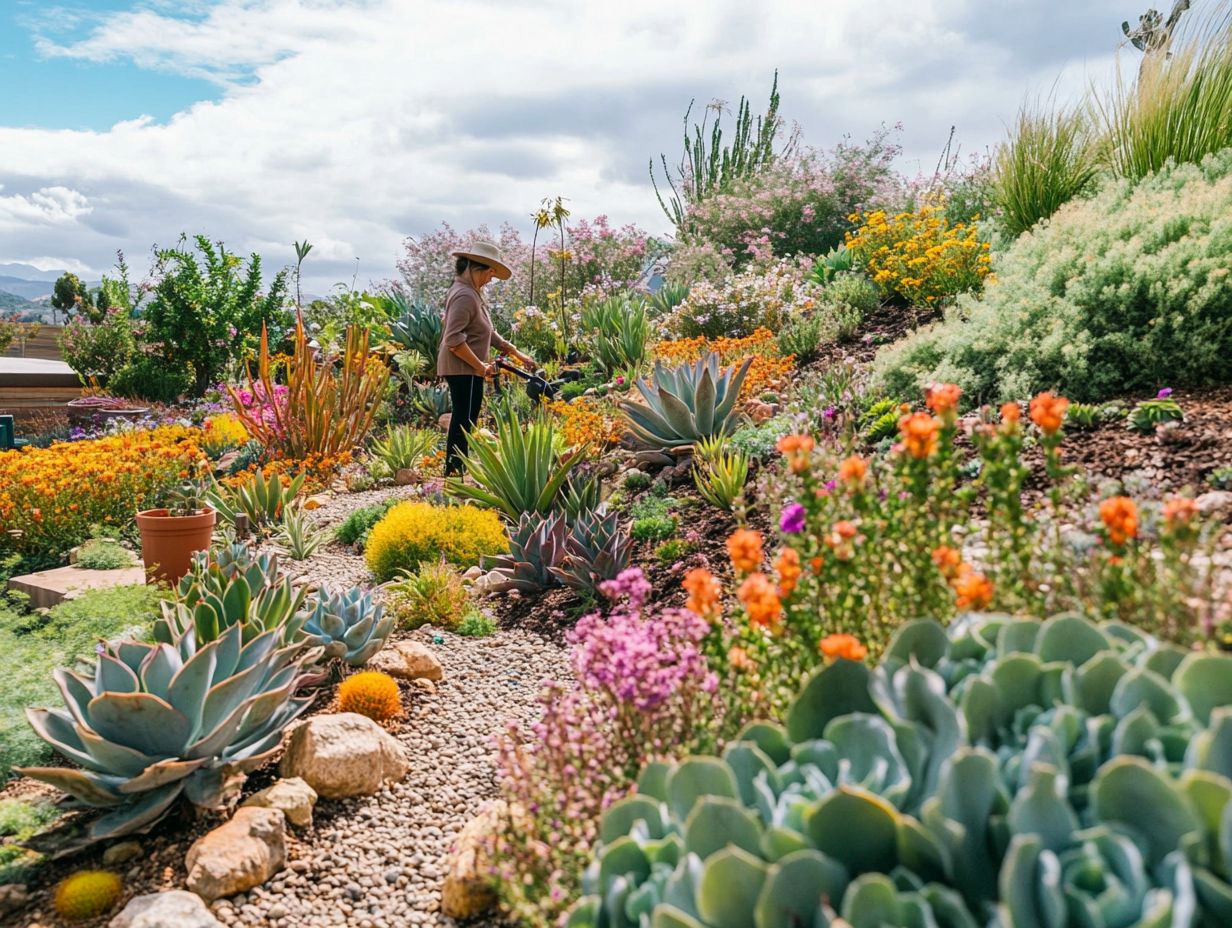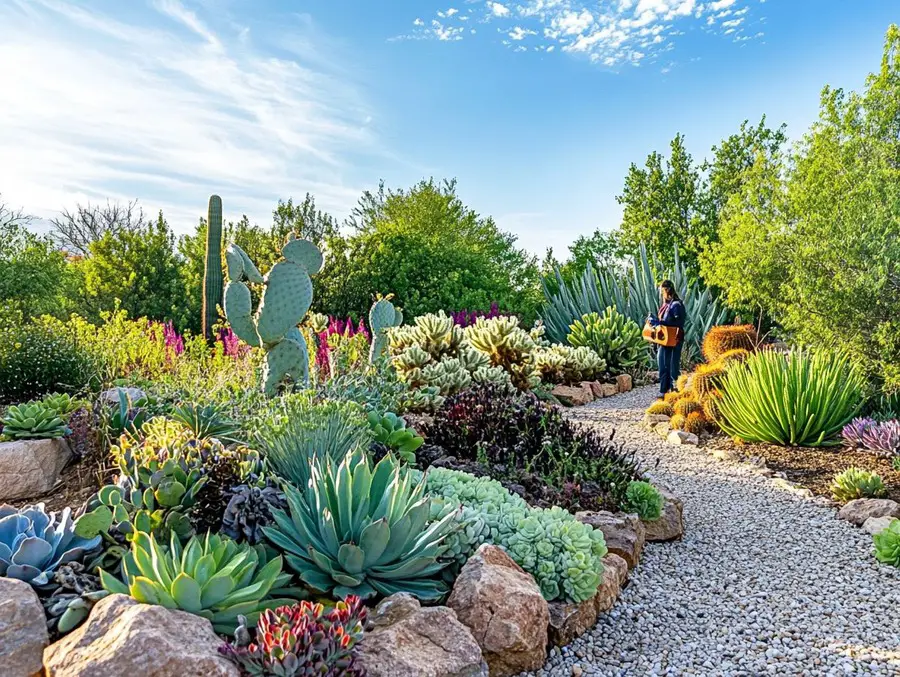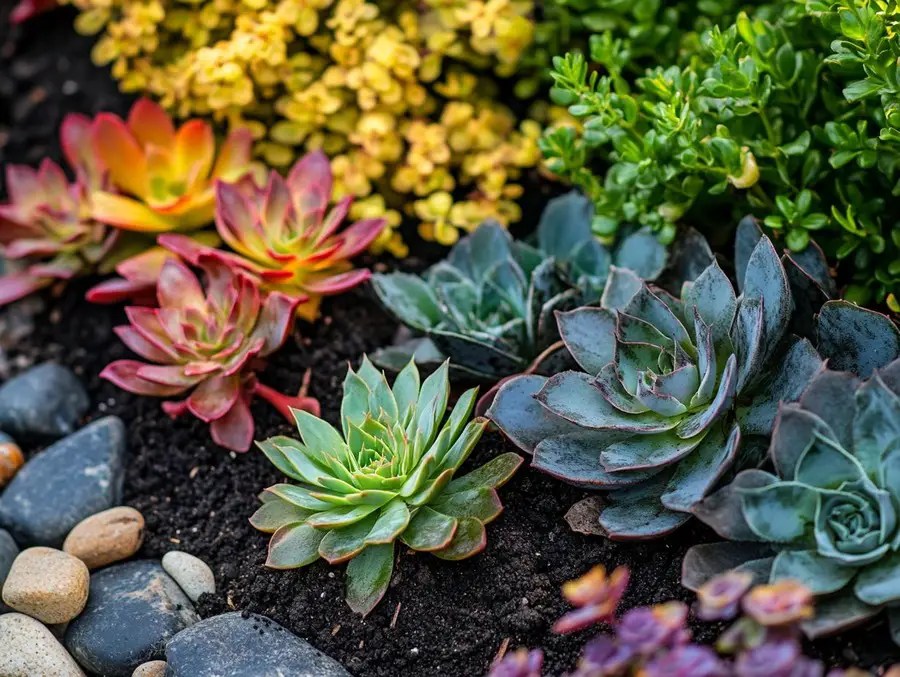We use affiliate links. If you purchase something using one of these links, we may receive compensation or commission.
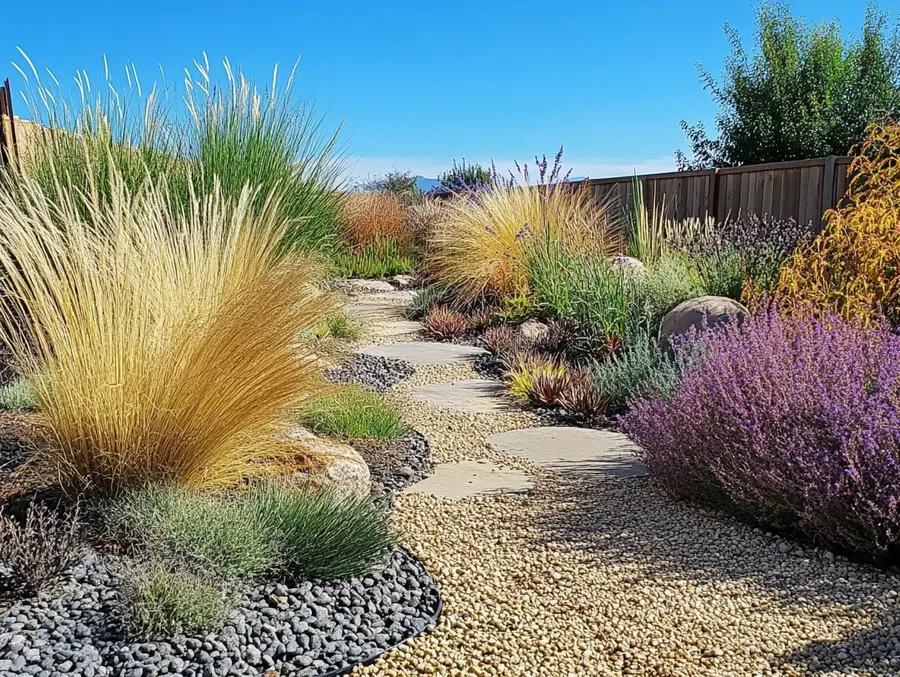
Ornamental Grasses for Xeriscaping can transform your landscape into a water-efficient, low-maintenance paradise.
Struggling to keep plants alive in dry conditions? Ordinary lawns and flower beds demand constant watering, but ornamental grasses thrive with little effort.
By choosing the right varieties, you’ll enjoy year-round texture, movement, and beauty—all while conserving water and reducing maintenance.
Ornamental Grasses for Xeriscaping
Key Takeaways
- Ornamental Grasses for Xeriscaping are drought-tolerant plants that add texture, movement, and color to low-water landscapes.
- Popular choices include blue fescue, feather reed grass, and fountain grass.
- These grasses thrive in arid conditions, require minimal maintenance, and help control erosion, making them ideal for sustainable landscaping in dry climates.
Ornamental Grasses for Xeriscaping: Lush, Drought-Resistant Picks
Xeriscaping is a fantastic landscaping approach that helps you conserve water while still creating a beautiful outdoor space.
One of the coolest features of xeriscaping is the use of ornamental grasses.
These plants add texture, movement, and visual interest to your garden, making it a real showstopper.
You’ll want to explore the benefits of incorporating these versatile plants into your landscape, figure out which varieties are best for your climate, and gather some tips for designing a stunning xeriscape.
There are essential maintenance practices to keep your ornamental grasses thriving.
With a little effort, you can transform your landscape into a sustainable oasis that you can enjoy for years to come.
What is Xeriscaping?
Xeriscaping is a clever landscaping technique that helps you conserve water by using drought-resistant and xerophytic plants that thrive in dry conditions.
This environmentally friendly approach to landscape design reduces the need for extra watering, making it perfect for areas with limited water resources.
By choosing native plants that don’t need much maintenance, you can boost the beauty of your garden while tackling issues like soil erosion and promoting biodiversity.
This technique saves water and also creates a stunning outdoor space that supports local wildlife and enhances the overall ecological balance.
Benefits of Using Ornamental Grasses in Xeriscaping
Incorporating ornamental grasses into your xeriscaping can really elevate the look and function of your outdoor spaces.
These versatile plants bring in a variety of textures and colors that change throughout the seasons, and they also help with soil erosion control and create habitats for local wildlife.
They’re super low maintenance, making them perfect if you’re a busy gardener who wants a stunning garden without putting in too much effort.
Ornamental grasses are champs when it comes to water-efficient landscaping, needing much less irrigation than your average flowering plants.
By choosing a diverse mix of ornamental grass varieties like Pampas grass or Miscanthus, you can create dynamic displays that keep your garden interesting all year round.
These grasses fit right in with various landscaping styles, whether you’re going for a modern minimalist vibe or a cozy cottage garden, and they help boost biodiversity, too.
They attract pollinators and support beneficial insects, which helps create a balanced ecosystem right in your yard.
With their ability to thrive in all sorts of conditions, including poor soil and drought-prone areas, ornamental grasses are a fantastic choice for sustainable gardening.
Bringing these resilient plants into your landscape adds beauty and also shows a commitment to environmental stewardship.
Choosing the Right Ornamental Grasses for Your Xeriscape
Choosing the right ornamental grasses for your xeriscape is key to creating a stunning and functional landscape that truly thrives in your environment.
Think about things like sun tolerance, shade tolerance, and soil types when you’re making your selections because different ornamental grass varieties fit into different conditions.
Knowing how the plants grow and their height will help you design a garden that looks great while showcasing the unique textures and colors of the grasses you pick.
By keeping these factors in mind, you can make sure your ornamental grasses boost your garden’s beauty and support its overall health and sustainability.
Factors to Consider
When you’re picking ornamental grasses for your xeriscape, there are some key factors that should steer your decision-making to create a thriving landscape.
First things first, get to know the specific environmental conditions in your garden.
Some grasses love to bask in dry, well-drained areas, while others thrive in moist, rich soils. Pay attention to that!
Next, think about the microclimates in your space. Are there sunny spots that soak up the light, or shady areas that stay cool?
Choose grass varieties that will thrive in those particular environments.
Don’t forget about the growth habit! It’s not just about how tall they get; it’s also about how they play nice with other plants in terms of texture and color.
Look for grasses with different blade shapes, like fine and coarse, to bring some visual flair to your landscape.
Consider seasonal interest as well. Grasses that turn vibrant colors in the fall can keep your garden looking fabulous even as the temperatures drop.
Opting for varieties that hold their shape during winter can add some texture to your garden when everything else is hibernating.
Finally, take the time to understand the watering and fertilization needs of the grasses you choose.
This will help you promote robust growth and keep your landscape looking its best for years to come.
Top Varieties for Different Climates
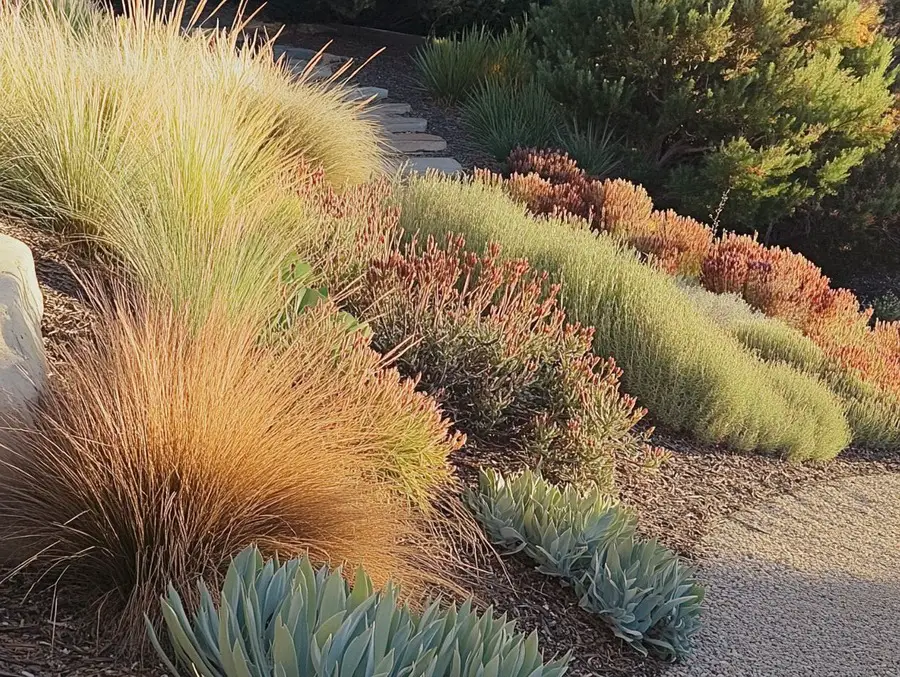
Choosing the right ornamental grass varieties for your climate is key to creating a xeriscape that really thrives in your local conditions.
When you pick grasses that match your unique environmental factors, you can craft a vibrant landscape that needs less water and invites beneficial wildlife into your garden.
Ornamental grasses are usually pretty resilient and can adapt to those temperature swings, giving you both beauty and functionality in your outdoor space.
If you’re in a northern region, consider cool-season grasses like Karl Foerster feather reed grass (Calamagrostis acutiflora).
They shine with their striking plumes throughout the summer and even into winter.
On the flip side, if you’re dealing with a more humid climate, varieties like Miscanthus sinensis can really steal the show with their tall, arching forms.
In the end, the versatility of these grasses makes them great choices for anyone looking to blend sustainable practices with a touch of aesthetic charm in their garden.
Designing with Ornamental Grasses in Xeriscaping
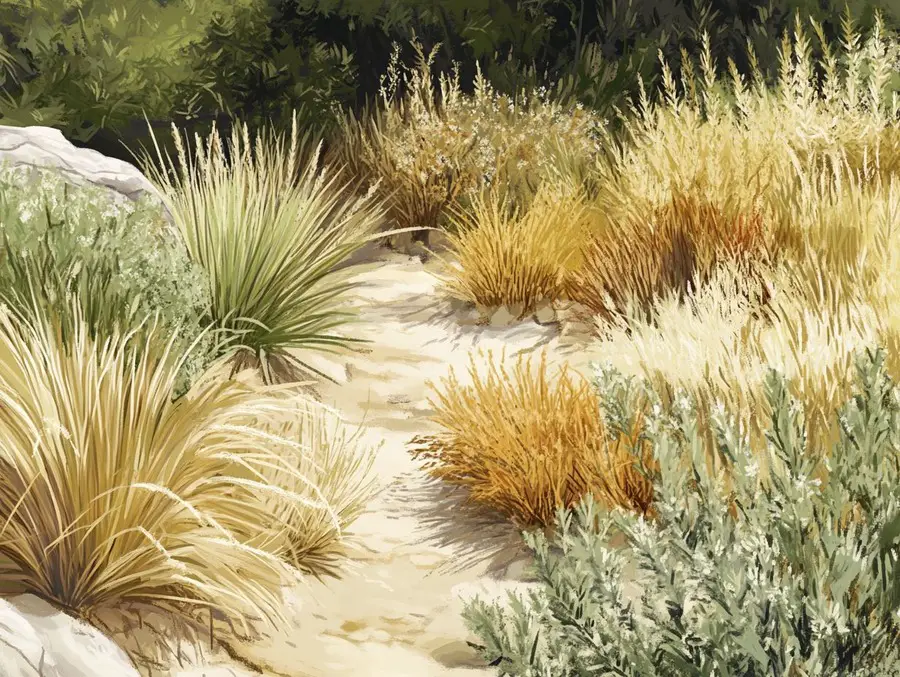
Designing with ornamental grasses in xeriscaping can really elevate your landscape design, adding both beauty and functionality to your outdoor space.
By grasping some essential design principles, you can effectively incorporate these versatile plants into your garden aesthetics.
Ornamental grasses are great for creating focal points, defining edges, or even serving as ground cover to enhance texture throughout the seasons.
Whether you decide to set up ornamental grass beds or mix them in with other low-maintenance plants, a bit of careful planning will help you create a visually stunning and environmentally friendly landscape that catches the eye and earns admiration.
Incorporating Grasses into Your Landscape
Incorporating grasses into your landscape can really transform ordinary spaces into vibrant, lively environments bursting with color.
Think about using ornamental grasses as natural borders or edging to define your garden areas and create some visual interest.
They can double as effective windbreaks, giving you a bit of privacy while protecting your other plants.
Mixing grasses with ornamental hedges can enhance the diversity and richness of your landscape design, it’s a great way to promote a habitat for local wildlife.
By thoughtfully integrating these ornamental grass features, you can craft a landscape that’s not just stunning but also ecologically beneficial.
The versatility of ornamental grasses opens up a world of creative combinations that can elevate your overall aesthetic.
For example, using taller varieties as backdrops adds dimension, while shorter grasses can bring a delicate softness to the front of your flower beds.
Placing these grasses along pathways can create a natural frame that guides the eye throughout your landscape, and incorporating them around seating areas softens those hard edges, making your space more inviting.
Exploring these methods will ensure that the grasses you integrate add both beauty and function, enriching the harmony of your environment.
Complementary Plants and Features
Choosing complementary plants and features is key to creating a harmonious xeriscape that boosts biodiversity and supports local wildlife.
When you pair ornamental grasses with companion plants, you enhance the overall health of your garden and attract those beneficial insects and pollinators.
By picking additional plants that go well with the grasses, you can craft an inviting habitat for all sorts of species, including birds and butterflies.
This mix of diversity doesn’t just make your landscape look great.
It also helps build a more resilient garden ecosystem.
Adding features like strategically placed rocks or native shrubs can offer shelter and nesting spots for wildlife.
If you introduce flowering plants alongside the grasses, you’ll extend the blooming season, ensuring that pollinators have a steady food source throughout the year.
By emphasizing the interdependence among your plants, you’ll create a dynamic environment that nurtures both the flora and the fauna.
Maintaining Ornamental Grasses in Xeriscapes
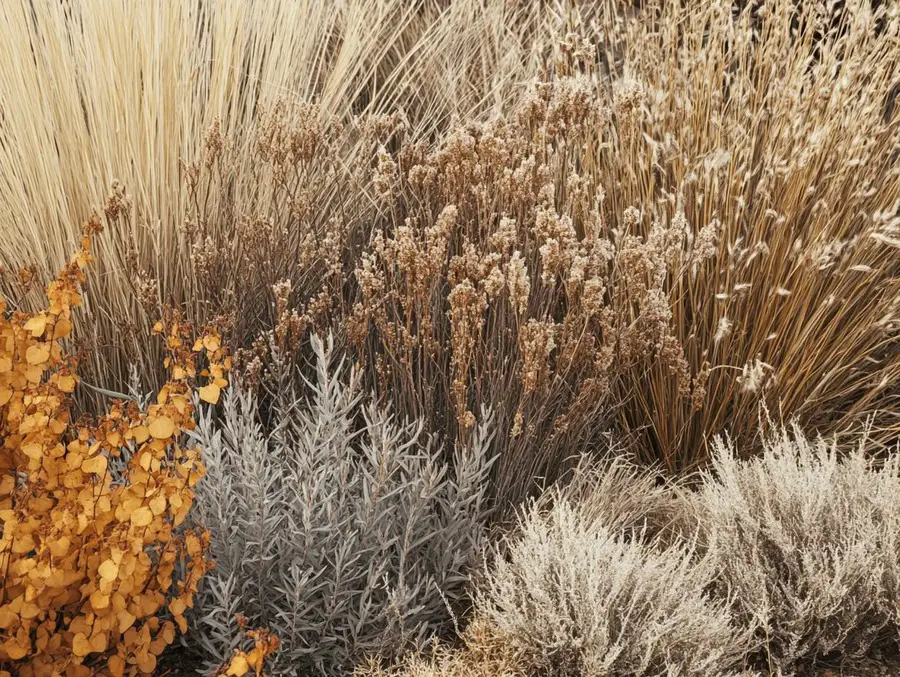
Keeping ornamental grasses in your xeriscape is key to making sure they thrive and look great for years to come.
It’s all about knowing the specific watering and fertilizing needs of each variety to help them grow strong and healthy.
Don’t forget about regular seasonal pruning.
This keeps your grasses looking sharp and encourages new growth and keeps pests at bay.
By following some effective maintenance practices, you can create a vibrant landscape that highlights the beauty and resilience of ornamental grasses while also being kind to the environment.
Watering and Fertilizing
Effective watering and fertilizing techniques are crucial for establishing and maintaining ornamental grasses in your xeriscape.
By understanding how different soil types retain moisture, you can create a watering schedule that meets the needs of your grasses while also conserving water.
For example, if you have sandy soil, it drains quickly and might need more frequent watering.
On the other hand, clay soil holds moisture but can lead to root rot if it gets too waterlogged.
Using methods like drip irrigation or soaker hoses can really help with moisture retention and ensure that water reaches the roots deeply, which ultimately reduces waste.
Don’t forget about organic mulch!
Applying it around the base of your grasses helps keep moisture levels just right and keeps those pesky weeds at bay.
In terms of fertilization, slow-release organic fertilizers are often your best bet.
They provide nutrients gradually, encouraging steady growth and reducing the risk of nutrient leaching.
By tailoring both your watering and fertilization methods to the specific soil type, you’ll create a thriving environment for your ornamental grasses.
Pruning and Winter Care
Seasonal pruning and winter care are key parts of keeping your ornamental grasses healthy and vibrant all year round.
Taking the time for this essential task doesn’t just rejuvenate your plants.
It also helps prevent rot and disease that can thrive on old, decaying foliage.
For many ornamental grasses, like Miscanthus or Pennisetum, late winter is the perfect time to give them that refresh.
This timing encourages lush new growth just in time for spring.
Don’t forget to apply a layer of mulch; it’s a game changer.
This simple step insulates the soil, suppresses weeds, and keeps moisture locked in.
Also, keeping an eye out for pesky critters like aphids and spider mites while your grasses are dormant is important.
Being proactive about monitoring can boost their resilience and overall health.
With these thoughtful practices, your ornamental grasses can flourish, bringing beauty and texture to your landscape.
Frequently Asked Questions
What are ornamental grasses and why are they suitable for xeriscaping?
Ornamental grasses are a type of plant that are usually grown for their aesthetic appeal.
They are suitable for xeriscaping because they are drought-resistant and require minimal watering.
What are some popular types of ornamental grasses for xeriscaping?
Some popular types of ornamental grasses for xeriscaping include blue fescue, feather reed grass, and fountain grass.
These grasses come in a variety of sizes, colors, and textures to add visual interest to your landscape.
Do ornamental grasses require any special care when used for xeriscaping?
Ornamental grasses used for xeriscaping do not require any special care.
They are low maintenance plants that can thrive in hot and dry conditions.
However, it is important to choose the right type of grass for your specific climate and soil conditions.
Can ornamental grasses be used as a substitute for traditional lawn grass?
Yes, ornamental grasses can be used as a substitute for traditional lawn grass in xeriscaping.
They can provide a similar lush and green appearance without the need for excessive watering and maintenance.
How can I incorporate ornamental grasses into my xeriscaping design?
Ornamental grasses can be used in various ways in xeriscaping.
They can be planted in groups or clusters to create a focal point, used as borders or edging, or even as a backdrop for other plants.
It is important to consider the height, color, and texture of the grasses when designing your landscape.
Are there any benefits to using ornamental grasses for xeriscaping?
Yes, there are several benefits to using ornamental grasses for xeriscaping.
They require less water, reduce the need for mowing, and can attract beneficial insects and pollinators to your garden.
Additionally, they can add texture, movement, and visual interest to your landscape.
Best Plants for Xeriscape Gardens: Hardy & Beautiful
Xeriscape Garden Styles: Easy Low-Maintenance Options
Xeriscape Gardening Techniques: Easy Low-Water Tips
Xeriscape Garden Design & Layout: Easy Water-Wise Beauty
What is xeriscaping? A beginner’s guide to drought-tolerant landscaping – Colorado State University
Related Content
Visit my Amazon Influencer Page for videos and gardening products Grow Your Own Garden

